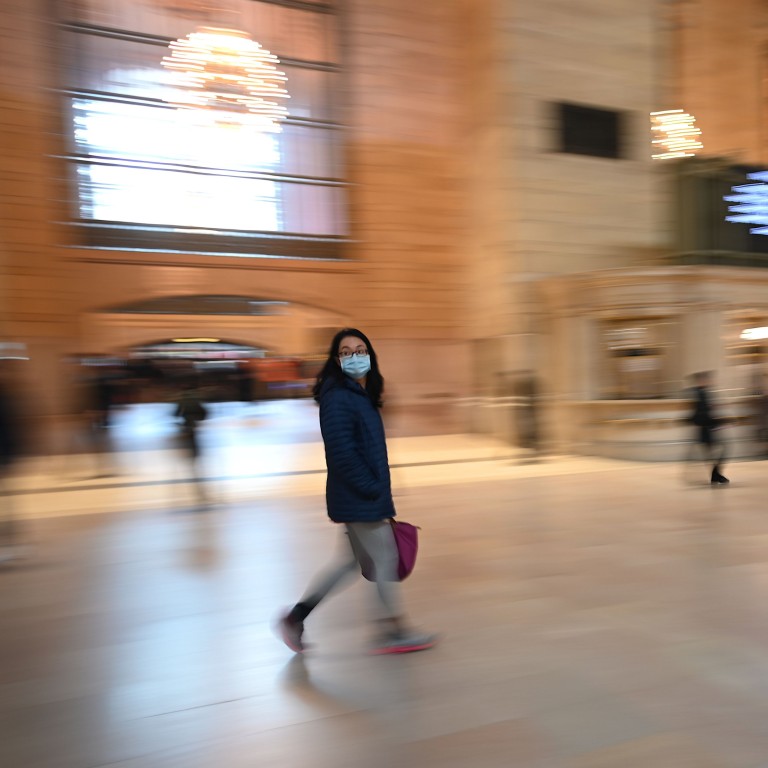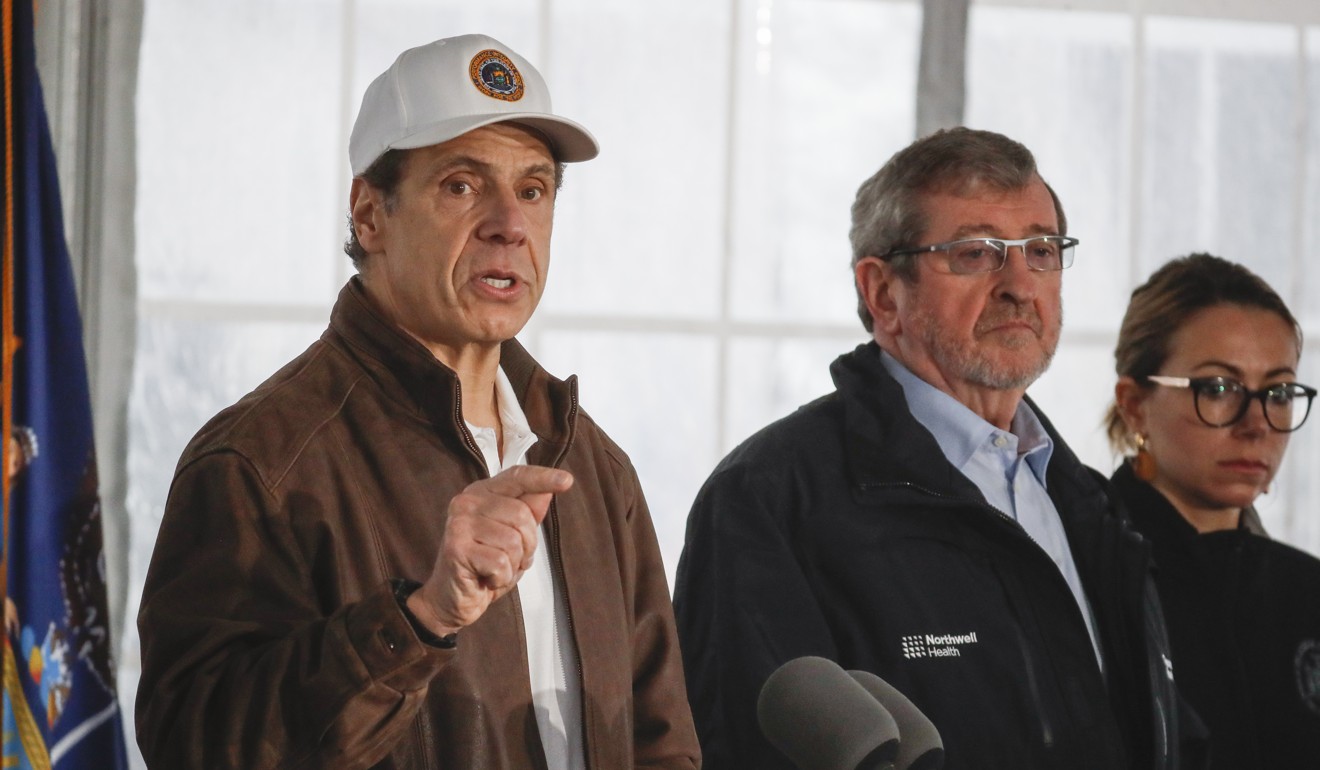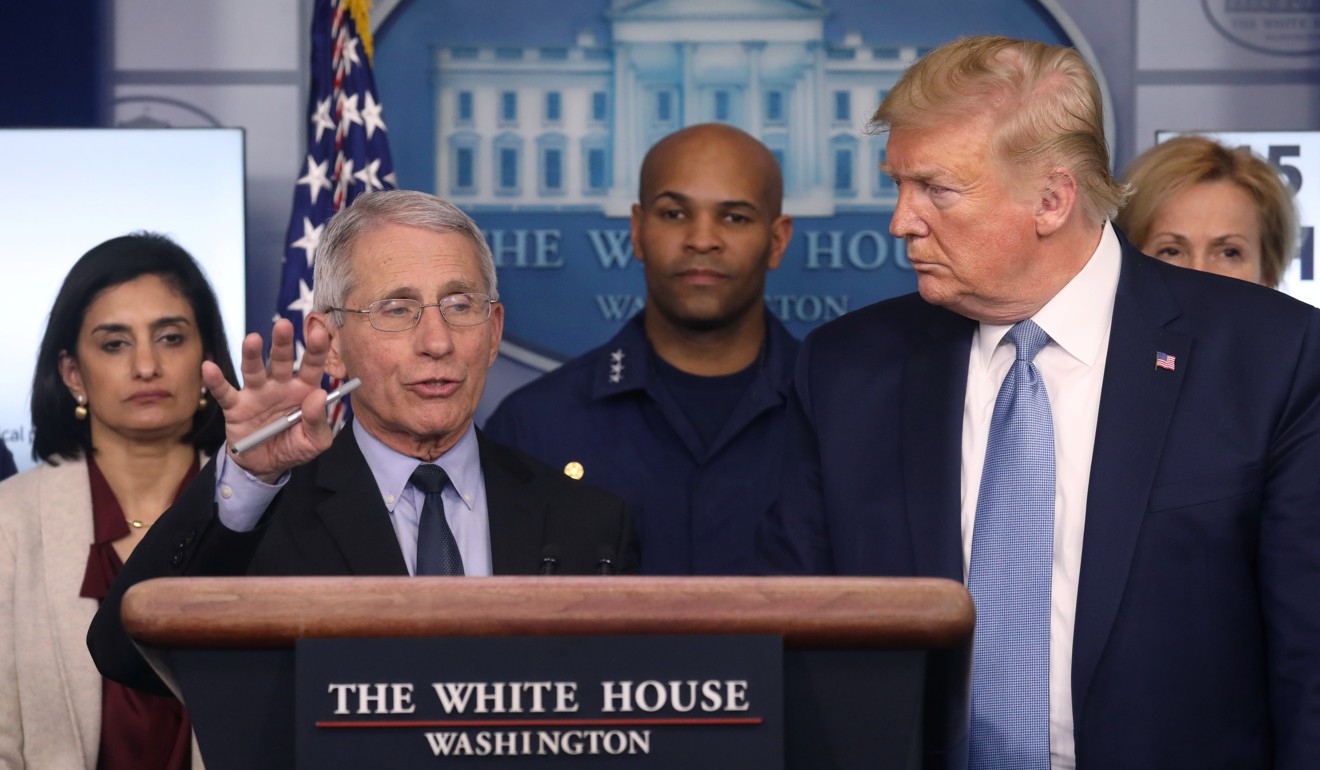
Coronavirus: will a mandatory lockdown be in the US’ future?
- Governors and mayors across the country, looking at a growing outbreak, close schools, shut restaurants, while urging people to stay home
- The voluntary approach may be less effective, but analysts note that coercive measures go against the values of a free society
As late as last week, US officials confronting the coronavirus outbreak were dismissing the idea that the country might even consider so drastic an option as to shut down entire cities — the way China did.
That was then. In just a few days, events have toppled conventional wisdom: infections in the US soared, surging in the last 10 days to reach more than 3,600 cases nationwide. US equities, meanwhile, had a week of sell-offs and entered a bear market, culminating Monday with a drop of 2,999 points in the Dow Jones Industrial Average, its biggest point loss ever.
Covid-19, now a global pandemic, is challenging US governmental leaders to weigh whether to set aside some core values of free societies and follow China’s example by forcibly quarantining entire cities.
All but one of the nation’s 50 states have confirmed cases of coronavirus, and 70 people have died in little more than two weeks. Governors of states and mayors of cities have announced a slew of actions to get people to sharply limit their activities – so far, still voluntarily.
Over the weekend, federal, state and local leaders fell short of calling for mandatory restrictions on citizens’ movements. Instead they closed schools, shut down restaurants, bars and everything from movie theatres to gyms, while urging people to stay home.
New York City Mayor Bill de Blasio announced that the city’s public school system – the nation’s largest, with 1.1 million students – would close until at least April 20, and that the city would also close its bars and restaurants, except for delivery and pickup services, for an indefinite period.
While hugely disruptive, the latest measures were still “far different from what was done in Wuhan with a mandatory quarantine and total shutdown,” said Samuel Brannen, who leads the Risk and Foresight Group at the Centre for Strategic and International Studies in Washington.
“But if we see a surge of cases in a specific place or multiple places, we could see [more mandatory] measures.”
He added: “We’ve already seen the National Guard called up by the New York governor to help with logistics of quarantine locations. We could see that mobilisation of National Guard forces by other states to enforce quarantines as well in the same way that different quasi-military forces were called up in China.”
Andrew Cuomo, the governor of New York – the state most severely affected, with 950 confirmed cases and nine deaths reported as of Monday evening – has announced drastic changes in rapid moves almost every day, including setting up a “containment zone” around a synagogue in New Rochelle determined to have been the origin of a cluster of cases.
On Monday, Cuomo joined with the governors of the neighbouring states of New Jersey and Connecticut to announce the latest restrictions, banning gatherings of more than 50 people – restaurants and bars, for example, will be closed across the region, though takeout and delivery services are still permitted.
That followed Cuomo’s announcement late last week that gatherings of 500 or more were prohibited, closing down Broadway theatres, concert halls and sporting events.
On Sunday, Cuomo said: “I am asking private businesses to aggressively consider voluntary closings and allow employees to work from home.”
“If businesses don't voluntarily cooperate, we will consider mandatory measures.”

Just a week ago, the same officials remained reluctant to say whether a China-style lockdown is a possibility in the US. But their answers indicated that the prospect was at least under discussion.
“Look, you don’t want to shut down society because that’s incredibly disruptive to life. But we also take the health care priority. It’s a balance of the two,” Cuomo said on Thursday.
The same day, Governor Jay Inslee of Washington, another badly hit state, said that “we are doing everything in our ability” to “avoid doing what China has done”. Washington banned gatherings of more than 250 people and urged people over 60 who have pre-existing conditions not to attend gatherings of any size.
“We understand it’s not 100 per cent,” Inslee said of the effectiveness of the voluntary approach. “We will rely on the good sense and good faith of the people in the county to recognise what they do might have consequences.”
Late on Monday, London Breed, the mayor of San Francisco, California, took the next step, announcing that as of midnight residents of the city and surrounding counties – totalling 6.7 million people – would be required to stay home “except for essential needs”.
Trump advises against gatherings of more than 10 people, has no plans for a lockdown
Even President Donald Trump has been confronted with the possibility: asked at a briefing Monday if a nationwide lockdown is being considered, he said: “At this point, not nationwide … But we may look at certain hotspots.”
China’s success
A mandatory quarantine policy seems to have worked for China, where the first coronavirus case appeared in December. After the initial cover-ups and confusion, Beijing ordered the lockdown of Hubei province, the epicentre of the disease, putting more than 50 million residents under mandatory quarantine, including the residents of Wuhan, the city of 11 million where the first cases emerged.
Other large cities such as Beijing and Shanghai also put their residents under strict surveillance, restricting movements outside their homes to only essential trips such as hospital visits and grocery shopping.
New cases in China have since dwindled to double digits daily; quarantine measures have been gradually lifted and a good percentage of businesses have resumed work. The actions are widely considered to have brought the outbreak under control.
Even so, the move at the time was criticised by Western academics as severe and inhumane.
Wendy Parmet, director of the Centre for Health Policy and Law at Northeastern University, told The New Yorker that “we have to be careful about everything we condone, whether active or passive”.
“This is the time when social norms can change, and personal liberties are at risk. By their nature, quarantines encourage xenophobia, division, and the muscular exercise of state power.
“There are also long-term political consequences,” she added. “The intangible consequences pushing toward authoritarian rule concerns me a lot.”
The number of infections in the US grows, hundreds more every day. A report by Deutsche Bank Research estimates 301,000 cases in the US by the start of June, when warmer weather might start to slow the disease’s spread.
“Reservations about China’s authoritarian system cannot disguise its apparent success in dealing with the coronavirus crisis,” said Jon Harrison, a macroeconomic strategist at TS Lombard, a London-based research firm.
“China’s response represents a template that other countries will need to emulate,” Harrison said.
South Korea’s model
Some suggested the US might look beyond China to other countries for guidance.
Kanti Bajpai, the director of the Centre on Asia and Globalisation at the National University of Singapore, said that “early intervention and mask-wearing” in South Korea, for example, had “shown to be effective without resorting to a draconian lockdown seen in China”.
But Brannen believes that the US has already missed that boat.
“You are relying on the health system, testing, and people to slow the spread,” Brannen said of South Korea’s measures.
“We’ve done none of that.”
The US isn’t new to crises. On September 11, 2001, after the World Trade Towers collapsed when terrorists flew airliners into them, governments at all levels quickly responded. But this time, facing a public health crisis, Washington has severely hampered the US reaction to the virus, Cuomo said.
In an opinion column Monday in The New York Times addressed to “Dear Mr President”, Cuomo wrote: “Every country affected by this crisis has handled it on a national basis. The United States has not. State and local governments alone simply do not have the capacity or resources to do what is necessary.”
Trump’s blunders
Trump played down its danger for weeks, insisting that the government had had “tremendous success at keeping the virus away”.
Recently, though, he reversed his position, acknowledging the virus’ threat, while continuing to tout the government response – for example, noting that the US had banned Chinese nationals from entering the country.
And in an address to the nation on Wednesday, he announced a further restriction, this time banning Europeans from entering the US – a recognition that Europe has now become the planet’s leading centre of outbreak.
Even so, little comprehensive strategy was put forward as leading agencies – the departments of Health and Human Services and of Homeland Security – were not given guidance from the White House, a health expert told the South China Morning Post.
As the situation worsened, the tone of government officials began to change.

Dr Anthony S. Fauci, the director of the National Institute of Allergy and Infectious Diseases, first appeared publicly three weeks ago alongside Vice-President Mike Pence – who leads the White House task force on the coronavirus – and applauded the government response then.
He has since come to admit the system was nowhere near what it should be.
“It is a failing. Let's admit it,” he said of the coronavirus testing capacity at a congressional hearing on Thursday.
And earlier in the week, Dr Fauci told Fox News it was now “possible that regional lockdowns could become necessary and recommended”.
To some, the voluntary approach is concerning – and ineffective. But many analysts note that such coercive measures go against the values of a free society.
“Mass quarantines are too blunt a tool, sweeping up many people who pose no risk to the public,” said Lawrence Gostin, faculty director of the O’Neill Institute for National and Global Health Law at Georgetown University.
“Even under a declared public health emergency, it is hard to envisage the courts upholding such a far-reaching restriction of liberty.”

Others say that such hesitation means that the window to limit the outbreak is narrowing.
“We’re losing valuable time,” said Scott Gottlieb, a former commissioner of the Food and Drug Administration, posted in a series of tweets last week.
“[The] longer we take to implement tough mitigation steps in areas of outbreak like Seattle, the larger, longer our epidemic curve will grow.”
Ideologically difficult
Brannen acknowledged that, even in a public health crisis, limiting people’s movements without violating basic human rights would be a fine line to walk.
“It will be an extraordinary thing to do for this country. Politically it will be proved to be difficult to say [restricting people mandatorily] needs to be done,” said Brannen. “Basically it was never done before.”
He noted that even after the September 11 attacks “we didn’t lock [New York City] down. It will be a break with tradition”.
“I agree the restrictions should be voluntary. But we are at the tipping point. This is the greatest threat to the human race on earth right now,” Brannen said.
“It’s first the human health issue. That comes before anything else.”
Additional reporting by Linda Lew
Purchase the China AI Report 2020 brought to you by SCMP Research and enjoy a 20% discount (original price US$400). This 60-page all new intelligence report gives you first-hand insights and analysis into the latest industry developments and intelligence about China AI. Get exclusive access to our webinars for continuous learning, and interact with China AI executives in live Q&A. Offer valid until 31 March 2020.

